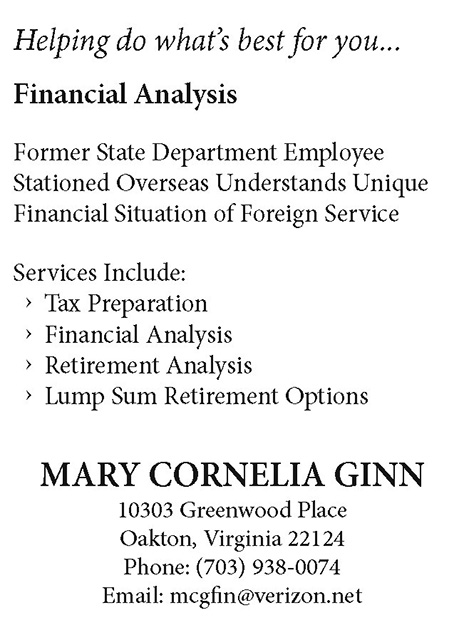An Insider’s Guide to the Re-Employed Annuitant Program
Having second thoughts about leaving government service? Here’s a candid and authoritative look at returning to work for the government.
BY JOHN K. NALAND
From 2015 to 2021, I worked as a re-employed Foreign Service annuitant at the State Department’s Foreign Service Institute. One of my duties was to give presentations at retirement planning seminars on post-retirement federal employment opportunities. Several thousand readers of this article no doubt watched one of those presentations. Below is an updated overview of the topic, accompanied by more candid commentary than I was able to give while speaking in an official capacity.
Employment after Retirement
If early- and mid-career employees think at all about life after the Foreign Service, they most probably envision happily turning in their badge and going on to pursue other interests. But as retirement nears, many of us have second thoughts about completely leaving government service. The topics and tasks that we worked on during our careers still interest and energize us. The knowledge, skills and abilities that we acquired over many years give us much to continue to contribute to the nation. And, especially for those of us obligated by the up-or-out system to retire in our late 50s or early 60s, we may need additional income for at least a few more years.
Thus, many newly retired Foreign Service members return to work for the government. A survey conducted by FSI of employees who retired in 2018 and 2019 found that 32 percent had taken new federal positions. Those numbers undoubtedly would have been higher if Secretary of State Rex Tillerson had not frozen hiring from February 2017 to March 2018.
Some Foreign Service retirees who return to government service find employment under a personal services contract (PSC) or, more rarely, in a full-time Civil Service job. But the vast majority work part time in the re-employed annuitant (REA) program. Because 85 percent of the Foreign Service works for the State Department and my REA experience was there, this article focuses on the REA program at State.
For information regarding the U.S. Agency for International Development’s similar short-term appointment roster (STAR) program, see USAID Automated Directives System (ADS), Chapter 414.3.3.6.
The Re-Employed Annuitant Program
The REA program, which previously went under the clunky title “while actually employed” (WAE), allows Foreign Service retirees to work up to half of each calendar year while still receiving their full federal pension (but see the note later in this article about annuity supplement payments). The specific limit is 1,040 hours, although the number actually worked varies from position to position. For example, I averaged 480 hours per year in my REA job. The work schedule also depends on the position. REAs sent overseas to cover staffing gaps at embassies and consulates might work several months straight, followed by a long inactive period, whereas my FSI position had me working every single month for an average of 40 hours.
In addition to the limit on hours worked, the REA program has an annual salary cap. Annual REA earnings plus your annuity payments may not exceed the higher of your annual base salary (including locality pay) at retirement or the annualized salary of the REA position. The cap’s 12-month calculation period starts on the day of your appointment. For those of us retiring under the Foreign Service Pension System, which came into force in 1984, our pensions rarely exceed 50 percent of our final salary, so the earnings cap usually does not come into play.
A survey conducted by FSI of employees who retired in 2018 and 2019 found that 32 percent had taken new federal positions.
Another important fact is that the REA program is decentralized. Each bureau controls its own positions and decides whom to hire to fill them. While retirees looking for REA opportunities can investigate multiple bureaus, only one bureau can put them on their REA rolls (bureaus can temporarily lend an REA to another bureau, but it is not done often). Appointments are for one year, subject to renewal if the bureau still has the need and liked your performance. REAs serve “at will” and thus can be terminated with no appeal. Bureaus are selective about the number of individuals on their rolls, as there are administrative costs associated with each name on the rolls.
Salaries vary from bureau to bureau and from job to job. I was paid as a GG (Government Grade)-13 Step 10 (currently $66.54 per hour before deductions for Social Security, Medicare and taxes), for example. But some REA jobs pay more, and some pay less. Note that most retirees under age 62 who are receiving an annuity supplement in addition to their regular pension face an earnings test that will reduce their annuity supplement by $1 for every $2 in wage income over $19,560 a year. Since REA salaries—like all wage and net self-employment income—are categorized as earned income, they factor into the earning test.
Bureaus pay for international travel, but typically only from Washington, D.C. Bureaus pay per diem during required training such as the Foreign Affairs Counter Threat course. REAs assigned overseas receive applicable allowances. A valid security clearance is always required. For overseas positions, a worldwide medical clearance is almost always required. Very few REA jobs are virtual.
REAs are paid only for the hours worked. They do not accrue annual leave or sick leave. REAs may not contribute to the Thrift Savings Plan. Federal health and life insurance premiums are deducted from their Foreign Service pension, not their REA salary. A rarely mentioned fact is that, even when not actively working, a retiree who is on a bureau REA roll is a federal employee and is thus subject to Hatch Act restrictions on certain political activities.
Network, Network, Network
Because the REA program is decentralized, there is no departmentwide list of job openings. This disappoints many retiring employees because it puts the onus on them to proactively contact one or more bureaus to ask about employment opportunities. This need to network is like lobbying for a highly bid job during your active-duty career—a task that many of us were looking forward to never having to do again in retirement.
Another hurdle facing job seekers stems from shortcomings in the departmentwide registry of retirees seeking positions. While retiring employees can and should submit their contact information to the REA Central Registry run by State’s Bureau of Global Talent Management, that registry has two limitations. First, it does not include a searchable database of past assignments, skills and languages spoken. Thus, the registry is of little use to a bureau looking for someone with specific experience or abilities. Second, many bureaus simply never consult the registry. Instead, they add names to their REA rolls only after people proactively apply to them.
Because the REA program is decentralized, there is no departmentwide list of job openings.
A final hurdle is that the number of REA applicants exceeds the number of positions available. Thus, employees nearing retirement who are interested in REA employment must expend effort to find opportunities and convince the hiring official that they meet their needs. For a retired consular officer applying to interview visa applicants during staffing gaps, that probably means not saying that you are unavailable to work in the summer. For someone applying to join an Office of Inspector General inspection team, that means being available to work continuously during a nearly four-month-long inspection cycle.
The best time to investigate potential REA jobs is in the year before retirement. That is when you still have access to the Global Address List and intranet staffing rosters to help you reach out to offices who hire REAs or contact past supervisors who might serve as a reference. While still on active duty, your security clearance remains valid, making post-retirement revalidation potentially quicker. And, as you go through your pre-separation medical exam, a few additional tests can be done to renew your medical clearance for REA work.
Some people ask if taking a six- to 12-month break at retirement to decompress before returning to work will harm their chances of finding a REA job. While the answer is probably yes, any disadvantage can be mitigated by keeping in touch with contacts in your bureau(s) of interest. But you will probably get a multimonth break even if you do not want it because it is rarely possible to start REA work immediately after retirement. Some bureaus have a long hiring process, and your security clearance may need a time-consuming update.
For those who have been retired for more than a year before seeking an REA job, finding one may be very difficult. Whether true or not, bureau hiring officials may assume that you have not kept up with current technology and office procedures. Also, eligibility for noncompetitive appointments to Civil Service positions, including REA jobs, expires three years after retirement.
For More Information

A limited amount of information on the REA program can be found on the State Department’s Retirement Network internet site at https://RNet.state.gov. It helpfully includes a list of bureau REA coordinators with telephone numbers and email addresses.
A 30-minute briefing on post-retirement federal employment opportunities is included in FSI’s four-day RV101 Retirement Planning Seminar. Those seminars are currently being presented virtually and are thus available to employees anywhere in the world. The next sessions are June 20-23, July 25-28 and September 26-29. For details, visit www.state.gov/career-transition-center-ctc.
For employees retiring via the RV102 Job Search/Transition Program, that presentation is followed by a panel discussion by representatives of offices that employ many REAs. In recent years, that panel has included the bureaus of Administration (declassification offices), African Affairs and Consular Affairs along with the Office of Inspector General (Office of Inspections) and USAID.
Read More...
- “Twelve Retirement Pitfalls to Avoid,” by John K. Naland, FSJ, April 2021
- “Playing the ‘REA’ Game—FS Work in Retirement,” by Lawrence Cohen, FSJ, May 2016
- “The Big Downsizing: Retirement Lessons,” by Eileen Malloy, FSJ, July-August 2015





